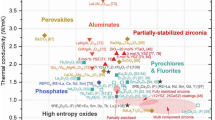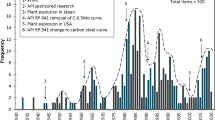Abstract
The propagation of fatigue cracks in 2024-T3 alclad sheet under fluctuating tension in different atmospheres has been studied. Of the principal contituents of air, water vapor had a much more severe effect than oxygen; in wet pure argon the endurance was much shorter than in dry pure oxygen. In air, other circumstances remaining unaltered, the endurance increased continuously at a reduction of the water vapour content; the endurance at a water content of the air of 20 ppm being about 6 times as long as in air saturated with water. Between the limits of 30°Jo and 100% relative humidity, as occurring in normal air, the endurance was only slightly affected. The thermodynamics and the mechanisms of the reactions of oxygen and water vapor with the metal are discussed.
Résumé
La propagation des fissures en fatique dans des atmosphères différentes a été étudiée pour des tôles minces de 2024-T3 plaquées. Parmi les ingrédients de l' air la vapeur d' eau avait une influence plus importance que l' oxygène, L'endurance en argon pur à grande humidité était inférieure à celle en oxygène sec pur. Réduction de la teneur en vapeur d' eau résultait dans une croissance continue de l' endurance: en air avec 20 p. p.m. d' eau l' endurance de la tôle était presque 6 × lonque qu' en air saturé, L'endurance était à peine influencée pas des altérations de l'humidité relative de l'air entre les limites 30 – 100 %, comme se produisant en pratique. La thermodynamique et le mécanisme des réactions de l'oxygène et de la vapeur d' eau avec le métal sont discutés.
Zusammenfassung
Die Fortpflanzungsgeschwindigkeit von Ermüdungsrissen in verschiedenen Casatmosphären wurde studiert für plattiertes 2024-T3 Blech. Von den Bestandteilen der Luft hatte Wasserdampf einen gröszeren Effekt als Sauerstoff; im naszen reinen Argon war die Lebensdauer viel kürzer als im trockenen reinen Sauerstoff. Bei Herabsetzung des Wasserdampfgehaltes nahm die Lebensdauer kontinuierlich zu. Die Lebensdauer unter wechselader Zugbelastung war bei einem Wassergehalt der Luft von 20 p.p.m. etwa 6 × gröszer als in gesättiger Luft. Die Lebensdauer wurde ka um beeinfluszt durch Änderungen in der relativen Feuchtigkeit der Luft zwischen den Grenzen 30 – 100 %, welche Feuchtigkeitsnormal in der Luft vorkommen. Die Thermodynamik und der Mechanismus der Reaktionen von Sauerstoff und Wasserdampf mit deco Metall werden diskutiert.
Similar content being viewed by others
References
H.J.Gough, D.G.Sopwith Atmospheric action as a factor in fatigue of metals. J.Inst. of Metals, 49 1932 p.93.
N.J.Wadsworth, H.Hutchings The effect of atmopsheric corrosion on metal fatigue. Philosophical Magazine, 3 1958 p.1154.
N.J.Wadsworth The effect of environment on metal fatigue. Proceedings Symposium on Internal Stresses and Fatigue in Metals. Edited by: Rassweiler,G.M. and Grube,W.L. Elsevier Publishing Comp. 1959, p.382.
T.Broom, A.Nicholson Atmospheric corrosion fatigue of age hardened aluminium alloys. J.Inst. of Metals, 89 1961 p.183.
J.A.Bennett The importance of environment in fatigue/failure metals. Proceedings of the Symposium held in Paris 1961 on Fatigue of Aircraft Structures. Edited by: Barrois,W. and Ripley,E.L. Pergamon Press 1963, p.1.
W.L.Holshouser, J.A.Bennett Gas evolution from metal surfaces during fatigue stressing. Proc. A. S. T. M. (1962) p.683.
W.L.Holshouser, H.P.Utech Effect of oleophobic films on fatigue crack propagation Proc.A.S.T.M. (1961) p.749.
J.L.Ham, G.S.Reichenbach Fatigue testing of aluminium in vacuum and the effect of pressure on life and surface appearance. Paper presented Fourth Pacific Area, National Meeting of A.S. T. M. Oct.1962.
G.A.Jenkins, W.T.Roberts The atmospheric corrosion-fatigue and stress-orrosion properties of a commercial high strength aluminium alloy extrusion. S and T Memo 14/62 Min. of Aviation.
J.R. Kramer, O.E. Podlaseck Behaviour of metals in vacuum. Martin Research Memorandum 102, Oct. 1961.
A.Hartman, F.A.Jacobs An investigation into the effect of oxygen and water vapour on the propagation of fatigue cracks on 2024-T3 alclad sheet. NLR report TN-M.2123 1964.
J.Schijve Analysis of the fatigue phenomenon in aluminium alloys. Thesis Technical University Delft, 1964.
J.Bénard Oxydation des métaux. Tome 1. Processus Fondamentaux. Gauthier-Villars, Paris, 1962.
T.P.Hoar Some fundamental features of mechano-chemical attrack on metals. AGARD Report No.158, 1957.
D.Broek, J.Schijve The influence of the mean stress on the propagation of fatigue cracks in alluminium alloy sheet. NLR report TN-M.2111, 1963.
J.Schijve, D.Broek, P.De Rijk The effect of frequency of an alternating load on the crack rate in a light alloy sheet. NLR report TN-M.2092, 1961.
Author information
Authors and Affiliations
Rights and permissions
About this article
Cite this article
Hartman, A. On the effect of oxygen and water vapor on the propagation of fatigue cracks in 2024-T3 alclad sheet. Int J Fract 1, 167–188 (1965). https://doi.org/10.1007/BF00186853
Received:
Issue Date:
DOI: https://doi.org/10.1007/BF00186853




